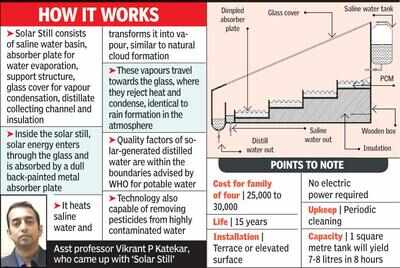- News
- City News
- nagpur News
- Engg professor develops solar-powered water purifier
Engg professor develops solar-powered water purifier

Nagpur: Considering the economic and environmental burden of conventional ways of water purification, a city engineering professor has come up with a model on solar distilling technology. The tank called ‘Solar Still’ processes the contaminated water using the natural method of evaporation and condensation.
Assistant professor Vikrant Pradip Katekar, the innovator, said the novel, energy-efficient and cost-effective solar distillation technology will create drinkable water from contaminated water. “The technology is ready for commercialisation and the patent has been granted recently for this work (patent number 402175),” he said.
He added that communities use various desalination systems, for instance, reverse osmosis (RO), multi-effect desalination, electrodialysis, multi-stage flash, ion exchange, solvent extraction and phase change. “Unfortunately, these processes are not economically feasible for producing a small amount of freshwater for typical households, particularly in rural and remote locations, as they consume a considerable amount of electric and/or thermal energy,” he said.
Katekar drew inspiration to develop Solar Still from a major challenge at home. “Water availability will be a big future challenge. In Manewada where I live, getting potable drinking water in summer is a challenge for residents. We have to store water for two days. The device is primarily for those who have a water source but it is contaminated,” he said.
In many areas, either the groundwater has high salt content or soil pollution affects the quality. People have to depend on groundwater or distillers because of non-availability of tap water. It took three days for Katekar to develop the device, which doesn’t consist of any special material.
“The still is a simple device. The main tank has steps like a step-well. The steps are made of copper plates painted in dull black to absorb more solar energy. More the surface area, more will be the energy absorption. The copper plates are dimple-shaped, and they increase absorption of solar energy,” he said.
Next to the tank is a reservoir container where water is received from the source. The top is covered with a glass to allow sun rays to heat the device.
“The glass cover works as one-way traffic — it only allows entry of solar rays and keeps them trapped. As the water starts heating, the pure water starts vapourising. When the vapours touch the glass cover which is cooler, they become droplets. The droplets slide due to gravity in the collecting channel at the lower end of the device,” Katekar added.
“The purified water obtained from the device is useful for drinking, medical use, cosmetic manufacturing, aquarium and charging of batteries,” he said.
Assistant professor Vikrant Pradip Katekar, the innovator, said the novel, energy-efficient and cost-effective solar distillation technology will create drinkable water from contaminated water. “The technology is ready for commercialisation and the patent has been granted recently for this work (patent number 402175),” he said.
He added that communities use various desalination systems, for instance, reverse osmosis (RO), multi-effect desalination, electrodialysis, multi-stage flash, ion exchange, solvent extraction and phase change. “Unfortunately, these processes are not economically feasible for producing a small amount of freshwater for typical households, particularly in rural and remote locations, as they consume a considerable amount of electric and/or thermal energy,” he said.
Katekar drew inspiration to develop Solar Still from a major challenge at home. “Water availability will be a big future challenge. In Manewada where I live, getting potable drinking water in summer is a challenge for residents. We have to store water for two days. The device is primarily for those who have a water source but it is contaminated,” he said.
In many areas, either the groundwater has high salt content or soil pollution affects the quality. People have to depend on groundwater or distillers because of non-availability of tap water. It took three days for Katekar to develop the device, which doesn’t consist of any special material.
“The still is a simple device. The main tank has steps like a step-well. The steps are made of copper plates painted in dull black to absorb more solar energy. More the surface area, more will be the energy absorption. The copper plates are dimple-shaped, and they increase absorption of solar energy,” he said.
Next to the tank is a reservoir container where water is received from the source. The top is covered with a glass to allow sun rays to heat the device.
“The glass cover works as one-way traffic — it only allows entry of solar rays and keeps them trapped. As the water starts heating, the pure water starts vapourising. When the vapours touch the glass cover which is cooler, they become droplets. The droplets slide due to gravity in the collecting channel at the lower end of the device,” Katekar added.
“The purified water obtained from the device is useful for drinking, medical use, cosmetic manufacturing, aquarium and charging of batteries,” he said.
FOLLOW US ON SOCIAL MEDIA
FacebookTwitterInstagramKOO APPYOUTUBE
Start a Conversation
end of article









